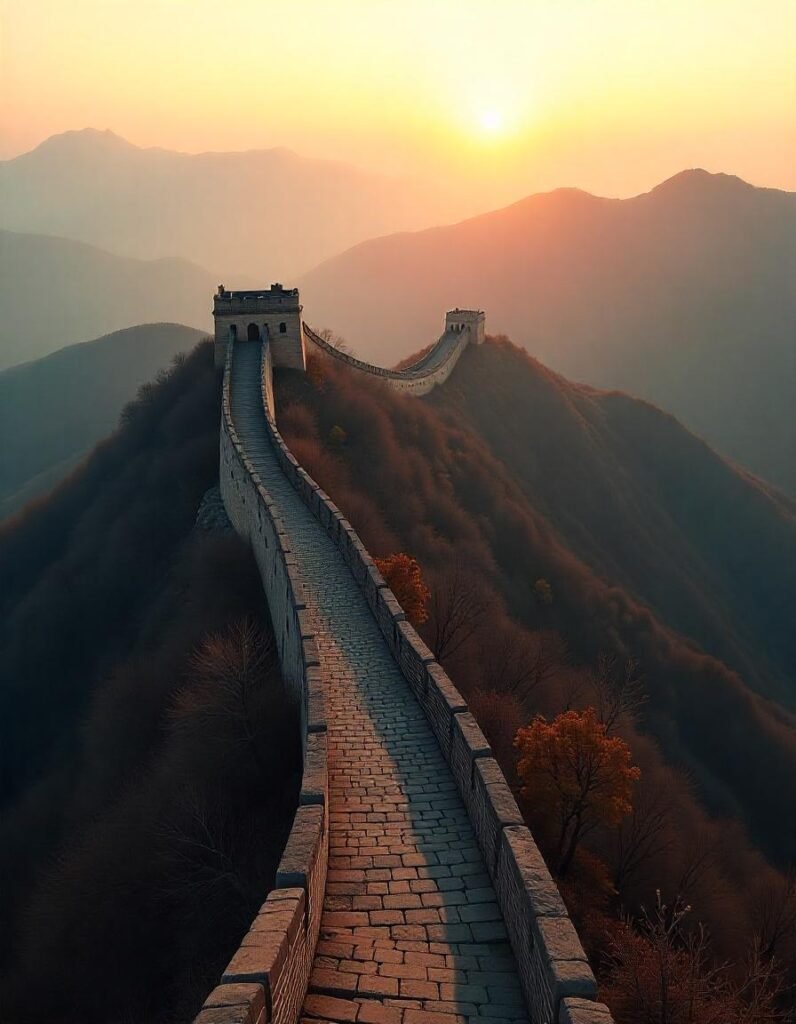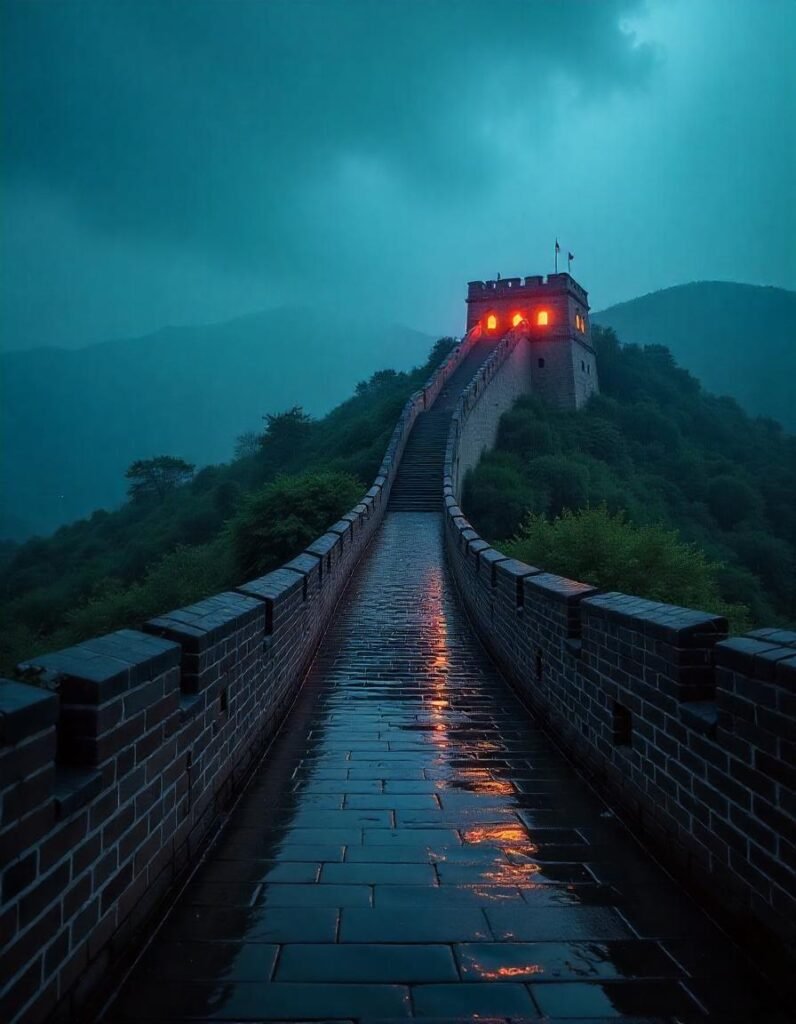The Historical backdrop of the Incomparable Mass of China: A Landmark of Strength and Strategy
Great Wall of China

The Incomparable Mass of China is quite possibly of the most famous and perceived structure on the planet. It isn’t just an image of China’s verifiable strength and assurance yet in addition a demonstration of the rich social and military legacy of old civilizations. Extending more than 13,000 miles, this engineering wonder has gone the distance and stays a getting through image of China’s obligation to safeguarding its kin and land.
In this article, we will investigate the captivating history of the Incomparable Mass of China, specifying its development, advancement, and the key authentic occasions encompassing it. We will likewise plunge into its social importance and cutting edge significance, making it quite possibly of the most spectacular milestone on the planet.
Starting points of the Incomparable Wall: Early Starting points
The historical backdrop of the Incomparable Mass of China traces all the way back to the seventh century BC during the early Fighting States time frame. Around then, the Chinese domain was isolated into a few primitive expresses, each seeking predominance. The requirement for safeguard against intruders, especially from northern clans like the Xiongnu, drove these states to build walls and strongholds along their boundaries.
The Main Walls: The principal walls were worked by various Chinese states, including the Qin, Zhao, and Yan realms, during the Fighting States time frame. These walls were fundamentally developed from earth and wood, intended to safeguard against attacks and intrusions. The idea of a nonstop, huge scope wall, be that as it may, didn’t emerge until the unification of China.
Qin Administration and the Start of the Incomparable Wall: The principal significant endeavors to interface and extend the walls came during the Qin Line (221-206 BC), under the rule of Sovereign Qin Shi Huang. Known for bringing together China and charging a few fantastic undertakings, Qin Shi Huang requested the connecting of the current walls to make a persistent hindrance along the northern outskirts. His vision was to shield the realm from roaming trespassers, essentially the Xiongnu clans from the north.
The Qin Administration’s rendition of the Incomparable Wall was not the stupendous construction we see today. It was a basic wall produced using slammed earth, intended to offer some security. Notwithstanding its fundamental development, this was a huge move toward the improvement of the Incomparable Wall.
The Han Line: Growing the Wall
After the fall of the Qin Line, the Incomparable Wall fell into decay for a long time. In any case, the Han Line (206 BC – 220 Promotion) carried recharged concentration to getting the northern boundaries. The Han rulers extended the Incomparable Wall into new regions, safeguarding the Silk Street shipping lanes that associated China with the West.
During the Han Line, the wall was reached out into the western districts, including portions of advanced Gansu, Ningxia, and Xinjiang. The Han Administration likewise supported the wall with block and stone in certain areas, giving it more noteworthy solidness and strength. The wall’s guarded reason additionally extended to incorporate insurance against attacks as well as controlling the development of individuals and merchandise.
The Ming Tradition: The Wall We Know Today

The most renowned adaptation of the Incomparable Mass of China, the one we perceive today, was worked during the Ming Line (1368-1644). Following quite a while of development, extension, and improvement, the Incomparable Wall arrived at its top during the Ming Tradition, with regards to both size and complexity.
The Fall of the Yuan Administration and the Ming Response: The Mongol-drove Yuan Line, laid out by Kublai Khan, had figured out how to overcome China in the thirteenth 100 years, yet it was at last ousted by the Ming Tradition. The Ming rulers perceived the danger of Mongol intrusions from the north and answered by sustaining the northern boundaries. This time denoted the start of huge scope development projects that would shape the Incomparable Wall as far as we might be concerned today.
Development Procedures and Materials: The Ming Extraordinary Wall was constructed utilizing a mix of block, stone, and wood, making it far more grounded and more solid than prior forms. The development cycle likewise incorporated the structure of lookouts, signal flames, and post stations along the wall to give viable guard and correspondence.
Vital Significance of the Wall: The Incomparable Wall was decisively positioned along the northern outskirts, which was powerless against intrusions from the Mongols and other migrant clans. The Ming rulers looked to safeguard their realm’s boundaries as well as the Silk Street shipping lanes and farming districts of northern China. The wall was frequently monitored by officers who might speak with other military units through signals, which included smoke signals and reference points.
Key Highlights of the Ming Extraordinary Wall: The Ming Tradition’s variant of the Incomparable Wall highlighted a few particular components, including:
- Watchtowers and Fortresses: Decisively positioned along the wall, these pinnacles permitted troopers to screen adversary developments and direction reactions.
- Beacon Towers: Utilized for correspondence, these pinnacles were fundamental for flagging messages across immense distances. They assumed a critical part in the early-advance notice arrangement of the wall.
- Defensive Features: The wall’s plan included highlights like railings, stages, and bolt cuts to give viable guard against intruders.
The Decay of the Incomparable Wall
By the late Ming period, the wall had filled its need yet was presently not as viable because of a few elements. With interior conflict, defilement, and the decay of military discipline, the wall turned out to be to a lesser extent an obstruction against trespassers. The Incomparable Wall was penetrated in 1644 when the Manchu-drove Qing Tradition took over China, vanquishing Beijing and bringing down the Ming Administration.
The Qing rulers, who came from Manchuria, didn’t have to depend on the Incomparable Wall to guard China. All things considered, they laid out another magnificent system and incorporated the northern districts. Over the long run, the significance of the Incomparable Wall lessened, and it fell into deterioration.
Advanced Significance and Safeguarding
While the Incomparable Mass of China no longer fills in as a tactical guard structure, it keeps on being a fundamental piece of China’s character and an image of versatility. The wall is currently one of the most well known vacation destinations on the planet, drawing a huge number of guests every year to encounter its verifiable importance and spectacular design.
The travel industry and Financial Impact: The Incomparable Mass of China has turned into a significant wellspring of the travel industry for China, with notable segments like the Badaling and Mutianyu areas close to Beijing being effectively open to global vacationers. The monetary effect of the Incomparable Wall is critical, as it upholds neighborhood economies and encourages social trade through the travel industry.
Safeguarding Efforts: In late many years, the Chinese government has put resources into endeavors to save and safeguard the Incomparable Wall. The wall faces a few dangers, including normal disintegration, enduring, and harm from human action. A few segments of the wall have gone through rebuilding projects, especially the more well known traveler regions. Nonetheless, protecting the Incomparable Wall completely stays a test, and a portion of the wall’s more remote and less open segments are at risk for breakdown.
UNESCO World Legacy Site: In 1987, the Incomparable Mass of China was assigned an UNESCO World Legacy Site, perceiving its social and verifiable significance to humankind. This assignment has assisted with pointing out worldwide the requirement for protection and has raised the wall’s status as one of the world’s most noteworthy structural accomplishments.
End: The Incomparable Wall as a Tradition of China’s Solidarity

The Incomparable Mass of China remains as a demonstration of the resourcefulness, diligence, and key vision of the old Chinese individuals. Its set of experiences, traversing north of 2,000 years, mirrors the advancing necessities of China’s safeguard and its craving to shield its kin from outside dangers.
From its unassuming starting points in the Fighting States period to its fantastic scope during the Ming Administration, the Incomparable Mass of China addresses one of the most aggressive designing accomplishments in mankind’s set of experiences. Today, it stays a getting through image of China’s solidarity, versatility, and rich social legacy. Whether it’s seen as a verifiable military guard, a work of engineering splendor, or a social symbol, the Incomparable Wall keeps on catching the creative mind of individuals all over the planet.
As we look towards the future, it is fundamental for keep saving the Incomparable Wall to guarantee that people in the future can insight and gain from this fantastic accomplishment. The Incomparable Mass of China isn’t simply an actual design however a living demonstration of the getting through soul of China and its kin.